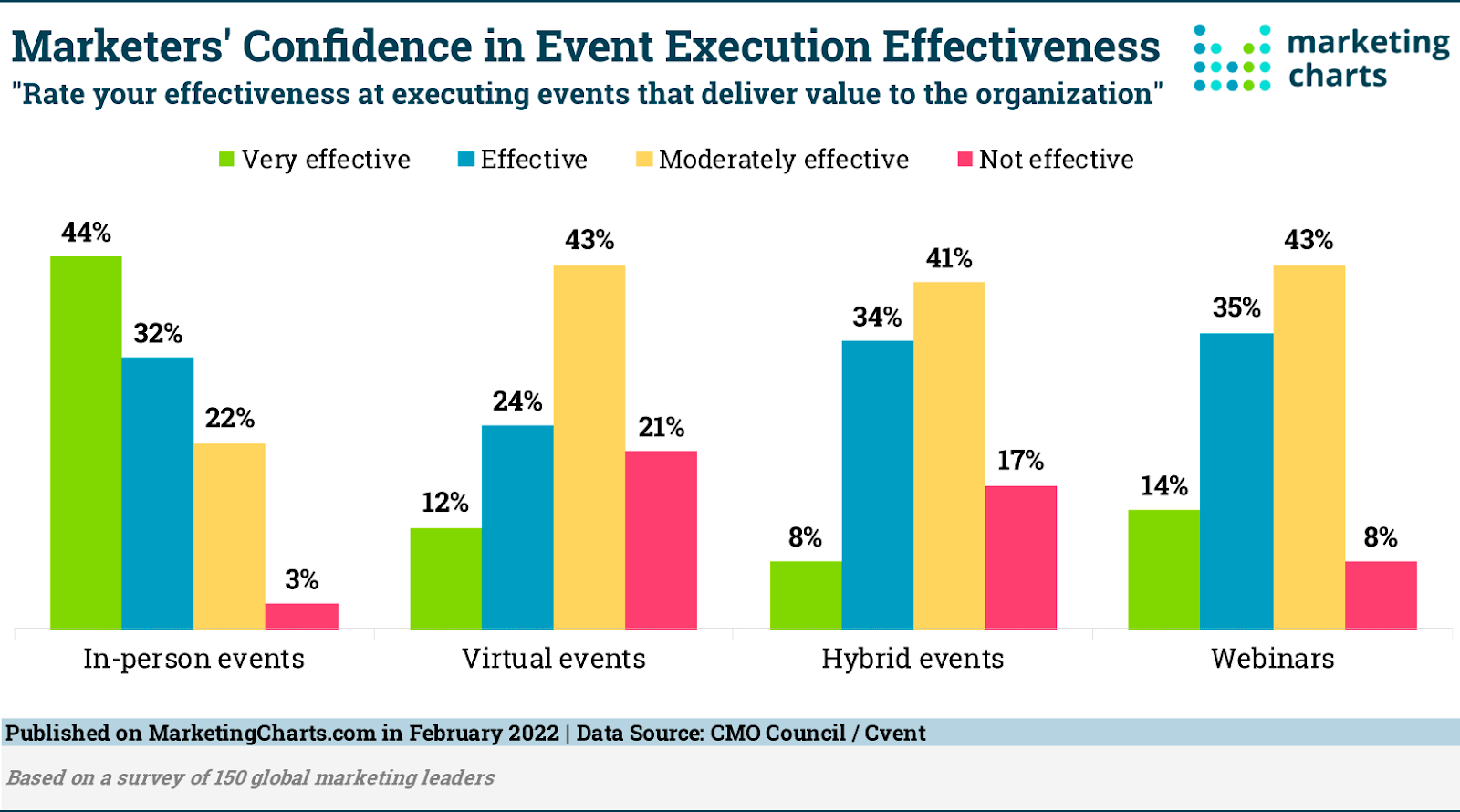The on-site event landscape has changed over the pandemic and there are new challenges to tackle. Here’s everything you need to know before you jump back in.
It’s been a rough couple of years for the event industry. According to Forbes, about 83 million people had to change their plans overnight. The anxiety of the virus spreading, national lockdowns and concerns about meeting in person brought the event industry to its knees. Meetings moved online and businesses struggled to connect with their community as they did with offline ones.
Two years on, offline events are back with a vengeance. With the vaccines being rolled out and the infection rates dropping, there’s finally a ray of hope. Events are steadily gaining momentum and people are beyond thrilled to make up for the lost time. With the world transitioning to normalcy, it’s vital to not throw caution to the wind.
A large number of businesses are still on the fence about having physical events. There’s a popular term “Reopening Anxiety” doing the rounds that embodies the fear of restrictions being loosened. The thought of being around large groups of people after a couple of years into the pandemic can feel overwhelming. It’ll take effort to build trust in all the event attendees so they know you are doing everything in your power to put their fears to rest.

As an event planner, there are certain guidelines you can follow to reassure your visitors. From asking for proof of vaccination to maintaining social distance, here’s a list of everything you should do to safely pivot to in-person events.
Should you collect proof of vaccination for the event?
Right now in most countries, it’s not necessary to ask for proof of vaccination. Given the drop in incidence rates and a larger part of the population being vaccinated, public gatherings have become relatively safer. However, if you still want to ask for it, you can do so as privacy laws allow you to.
While making this decision, get a pulse of your audience. If your crowd has a younger age group, it’s more likely they’d be comfortable with not having to disclose their vaccination status. If the event has a more established corporate crowd, ask them what would make them feel safe beforehand. This should help you make a call if it’s necessary to ask for proof of vaccination.
A check-list of safety measures for the venue
Whether you’re hosting the event indoors or outdoors, it’s important to manage the risk of COVID-19. This means taking deliberate precautions to prevent the spread of the virus and bringing down the risk of exposure. It also means taking steps to avoid financial losses that can happen because of the pandemic. We’ve put together a list of things you can carry out at your event.
I. Implement touchless technology
Use technology to make your event a safer space. You can avoid physical contact by using sensors and scanners that detect certain movements and make the process more efficient. Here’s how automation can come into play to improve your attendees’ event experience:
- Automatic door sensors
- Contactless check-in kiosks
- Scannable QR codes to print badges
- RFID bracelets for payments
- Automatic hand sanitiser dispensers
- Motion-sensor toilets
II. Be on the lookout for indoor-outdoor spaces
It helps to have an indoor and outdoor venue where people can spread out. Being able to get some fresh air is necessary, especially during COVID times. This will also give your visitors enough space to maintain social distance and avoid coming in close contact with others.
While charting out your event’s floorplan, designate areas for both indoor and outdoor activities. You will also have to make a note of what you’d have to procure for these spaces. For example, you’d need wifi, a seating area, gadgets, and weatherproof equipment in case of an emergency.
Keep a tab on everything you’d need and maybe include your attendees while creating a checklist so you have everything in one place.
III. Pick out food and beverage options that cater to your audience
The pandemic has brought health into focus. People are more conscious of their food choices and try to keep their intake as healthy as possible. You can make their experience at the event significantly better by taking these choices into consideration.
- Send out a survey asking your guests about their food preferences and allergens beforehand. This should give you a good idea of what to have on the menu.
- Provide organic and healthy choices so it fits a range of culinary requirements.
- Options like to-go meals, single portion boxes, and packaged snacks give your audience more confidence that the food has been handled with care and with minimum exposure.
- You can decrease alcohol consumption by giving out packaged drinks with low-alcohol content and non-alcoholic premium drinks rather than just soda.
IV. Ensure sanitizing products are readily available
Experts believe that the risk of being infected by COVID-19 from a surface is low when compared to direct face-to-face contact. But this increases when there are a huge number of people touching the same things. You can reduce this risk by providing:
- Disinfecting wipes
- Extra masks
- Hand sanitiser
- Trash cans to discard wipes and masks
V. Explore flexible contract terms as a safety net
One of the most important lessons the pandemic taught us was that the only thing that remains constant is change. Things can turn around in the blink of an eye and you’ve got to be prepared for it. To ensure your peace of mind, look for venue providers who offer flexible contracts that include:
- Cancellation and postponement clause in your contract that’ll allow you to recover a part of your money if your event is cancelled or moved.
- Force majeure clauses in contracts protect you from liability caused by external events that couldn’t be foreseen or controlled.
- Event insurance offers a financial cushion to in-person event planners in case of potential extreme conditions.
Factors to be considered while creating an exposure management plan
Asking for proof of vaccination or a COVID test is one of the first steps of screening your event but it’s not an air-tight plan. When you’re developing your safety guidelines, you also need to consider the possibility that there might be a transmission of the virus and plan ahead for it. After developing the safety protocol, make sure your community is aware of it by sharing it on your website and at the event.
Have a medium that your event audience can reach out to if they test positive for COVID 19. With the guidelines you have in place, you’ll have a clear road map of how to handle this. It’s important to keep your event attendees in the loop. Also, contact the local public health officials and inquire about these details:
- What information do you have to disclose to the people who were at the event?
- Who is going to share this information and when should it be done?
- How will you report this information to everyone involved?
- What do you do if someone tests positive during an event that’s spread over days?
Keep an eye on local vaccination and transmission numbers
COVID tracking websites with infection rates are easily available online. Keep track of them and see if the area where you’re hosting the event is a hot spot. If the transmission rates are low, you can breathe easy. If it’s high then be mindful of your event size and ask your attendees to stay home if they have any COVID symptoms.
Final thoughts
As an event manager, the main goal is to make sure everyone feels included, engaged, and safe during the event. By taking a few extra steps and planning things differently with the pandemic in mind, this roadmap will help you navigate your return better. Ensure you have your safety protocols in place, your community feels comfortable and most importantly, don’t forget to have fun!
Ready to jump back into in-person events? Contact our team to explore Converve’s event platform to host an unforgettable experience.



